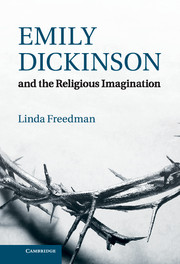Chapter 5 - Sacrifice
Published online by Cambridge University Press: 07 September 2011
Summary
The narrative of crucifixion is one of journey and climax – the struggle in Gethsemane and the death on Calvary. Calvary, seen in the broader context of sacrificial narrative, was of thematic and structural importance to Dickinson’s poetry. Thematically, Dickinson uses the crucifixion to express her ambivalent feelings about martyrdom and the poetic quest. She also relies on the love and grief of a man, whose humanity opens a path to divinity, to express her own emotional anguish in the face of an unknowable beyond. Structurally, the sacrificial giving of self allows Dickinson to explore the poetic relationship between the self’s essence and its representation.
It has become a commonplace of Dickinson criticism to say that she turned to Christ as a representative man of suffering. This chapter takes that idea in a new direction by opening up the theological meaning of that suffering. Suffering on the cross draws attention to the narrative of finite infinity because it returns us to the problems of the Word made flesh. Dickinson inherited a concept that articulated both the unbridgeable difference and the compact union of humanity and divinity. Christ’s sacrifice emphasises the condition of that union at the very moment it is about to be dissolved. His death is, by definition, an intensely mortal experience but it is also fundamental to his redemptive mission. Dickinson’s Puritan ancestors approached the issue by focusing on God’s condescension to be man; her more liberal contemporaries frequently emphasised a humanistic approach. Drawing from the twentieth-century theology of Jürgen Moltmann, this chapter explores the relationship between theological and poetic interpretations of Christ’s death.
- Type
- Chapter
- Information
- Emily Dickinson and the Religious Imagination , pp. 126 - 157Publisher: Cambridge University PressPrint publication year: 2011



